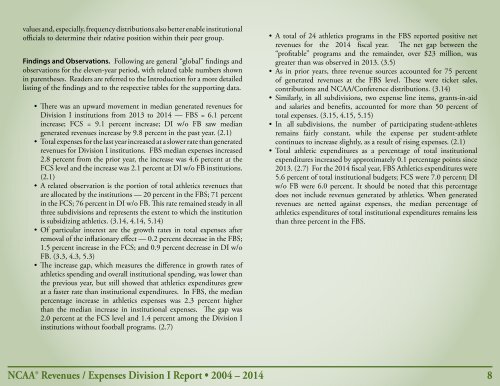Revenues & EXPENSES
2015 Division I RE report
2015 Division I RE report
- No tags were found...
You also want an ePaper? Increase the reach of your titles
YUMPU automatically turns print PDFs into web optimized ePapers that Google loves.
values and, especially, frequency distributions also better enable institutional<br />
officials to determine their relative position within their peer group.<br />
Findings and Observations. Following are general “global” findings and<br />
observations for the eleven-year period, with related table numbers shown<br />
in parentheses. Readers are referred to the Introduction for a more detailed<br />
listing of the findings and to the respective tables for the supporting data.<br />
• There was an upward movement in median generated revenues for<br />
Division I institutions from 2013 to 2014 — FBS = 6.1 percent<br />
increase; FCS = 9.1 percent increase; DI w/o FB saw median<br />
generated revenues increase by 9.8 percent in the past year. (2.1)<br />
• Total expenses for the last year increased at a slower rate than generated<br />
revenues for Division I institutions. FBS median expenses increased<br />
2.8 percent from the prior year, the increase was 4.6 percent at the<br />
FCS level and the increase was 2.1 percent at DI w/o FB institutions.<br />
(2.1)<br />
• A related observation is the portion of total athletics revenues that<br />
are allocated by the institutions — 20 percent in the FBS; 71 percent<br />
in the FCS; 76 percent in DI w/o FB. This rate remained steady in all<br />
three subdivisions and represents the extent to which the institution<br />
is subsidizing athletics. (3.14, 4.14, 5.14)<br />
• Of particular interest are the growth rates in total expenses after<br />
removal of the inflationary effect — 0.2 percent decrease in the FBS;<br />
1.5 percent increase in the FCS; and 0.9 percent decrease in DI w/o<br />
FB. (3.3, 4.3, 5.3)<br />
• The increase gap, which measures the difference in growth rates of<br />
athletics spending and overall institutional spending, was lower than<br />
the previous year, but still showed that athletics expenditures grew<br />
at a faster rate than institutional expenditures. In FBS, the median<br />
percentage increase in athletics expenses was 2.3 percent higher<br />
than the median increase in institutional expenses. The gap was<br />
2.0 percent at the FCS level and 1.4 percent among the Division I<br />
institutions without football programs. (2.7)<br />
• A total of 24 athletics programs in the FBS reported positive net<br />
revenues for the 2014 fiscal year. The net gap between the<br />
“profitable” programs and the remainder, over $23 million, was<br />
greater than was observed in 2013. (3.5)<br />
• As in prior years, three revenue sources accounted for 75 percent<br />
of generated revenues at the FBS level. These were ticket sales,<br />
contributions and NCAA/Conference distributions. (3.14)<br />
• Similarly, in all subdivisions, two expense line items, grants-in-aid<br />
and salaries and benefits, accounted for more than 50 percent of<br />
total expenses. (3.15, 4.15, 5.15)<br />
• In all subdivisions, the number of participating student-athletes<br />
remains fairly constant, while the expense per student-athlete<br />
continues to increase slightly, as a result of rising expenses. (2.1)<br />
• Total athletic expenditures as a percentage of total institutional<br />
expenditures increased by approximately 0.1 percentage points since<br />
2013. (2.7) For the 2014 fiscal year, FBS Athletics expenditures were<br />
5.6 percent of total institutional budgets; FCS were 7.0 percent; DI<br />
w/o FB were 6.0 percent. It should be noted that this percentage<br />
does not include revenues generated by athletics. When generated<br />
revenues are netted against expenses, the median percentage of<br />
athletics expenditures of total institutional expenditures remains less<br />
than three percent in the FBS.<br />
NCAA® <strong>Revenues</strong> / Expenses Division I Report • 2004 – 2014 8


